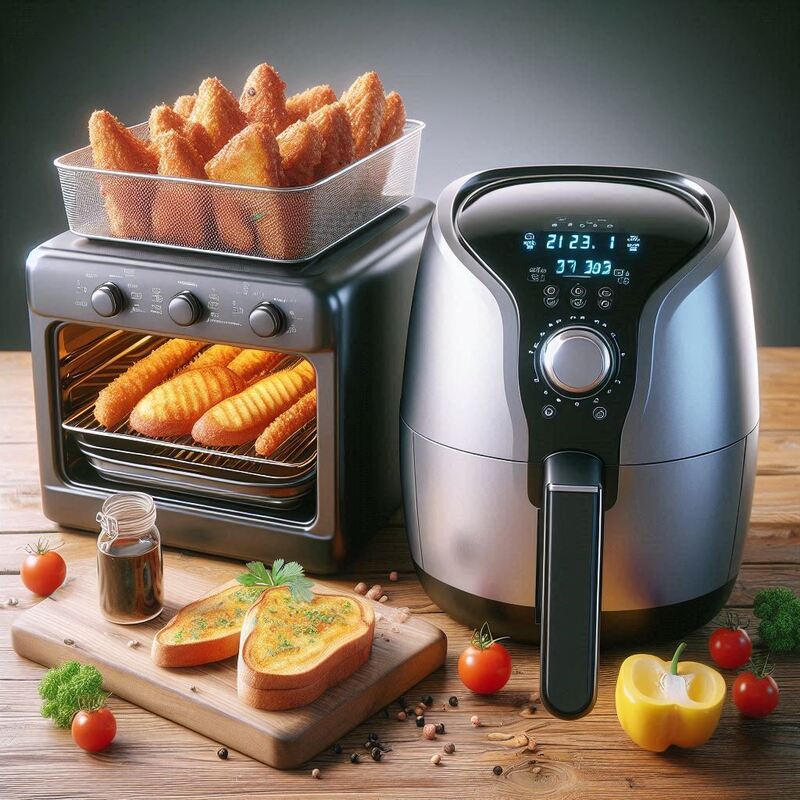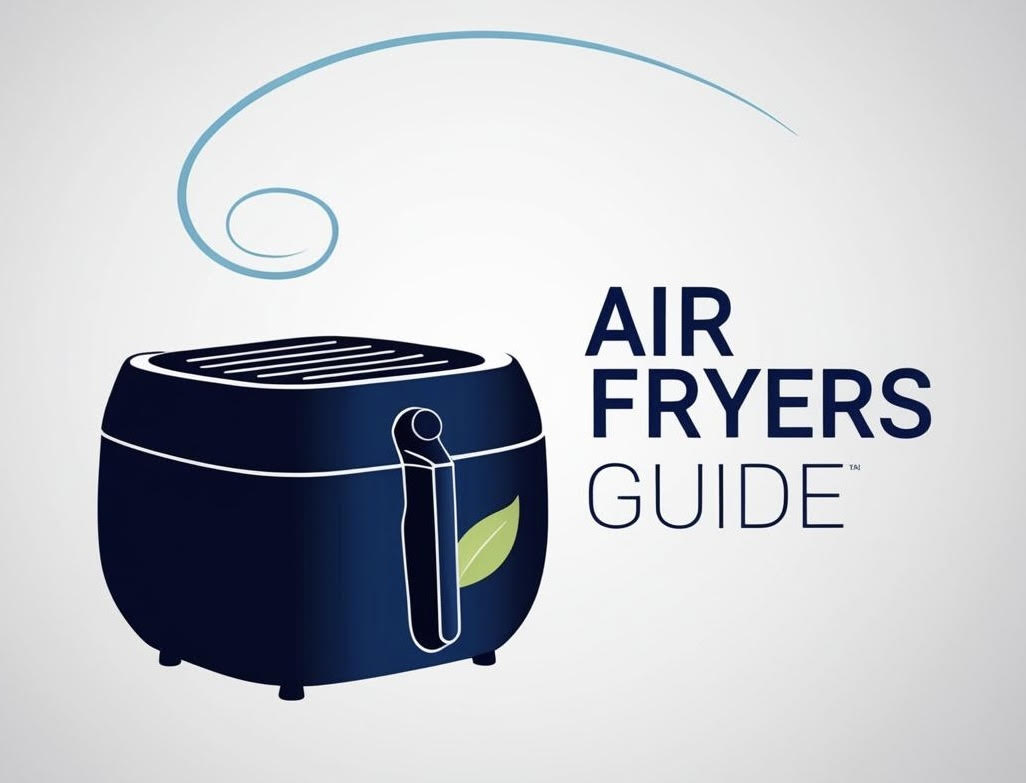Air Fryer vs. Toaster Oven: Which Countertop Appliance is Right for You?

Countertop ovens have long been popular for their ability to handle smaller baking, broiling, and toasting tasks without needing to heat up a large main oven. The air fryer, a more recent and popular innovation, promises faster cooking and significantly crispier results, often with less oil. With the rise of versatile "air fryer toaster ovens," the lines between these appliances have become increasingly blurred. Let's take a detailed look at the dedicated air fryer versus the standard toaster oven and the capabilities of the increasingly popular combination units to help you decide which is best for your kitchen.
How They Work: Heating Methods & Airflow
- Standard Toaster Oven: Primarily uses heating elements (usually on the top and bottom of the cavity) for radiant heat, which is ideal for toasting bread, melting cheese, or baking small items like cookies or individual pizzas. Some may have a very slow fan for basic convection, but it's not the primary cooking mechanism.
- Dedicated Air Fryer: Uses a powerful, high-speed fan located near a heating element (often at the top) in a relatively small, compact cavity. This setup creates intense forced convection, specializing in blasting super-heated air directly onto the food surfaces for rapid cooking and maximum crisping.
- Air Fryer Toaster Oven: Combines the features of both. It utilizes heating elements for toasting/baking/broiling and also includes a fan for convection cooking and a dedicated "Air Fry" function. The fan is typically more powerful than in a standard convection toaster oven, but the airflow may be less concentrated or intense than in a dedicated, compact air fryer due to the larger oven cavity size.
The intensity and focus of the airflow are the main distinctions driving their differing capabilities.
Key Differences & Capabilities
While they all share countertop space, these appliances differ in their primary strengths:
Primary Function & Cooking Results
- Dedicated Air Fryer: Built specifically for speed and maximum crispiness on smaller items. Excels at achieving a satisfying "fried" texture with much less oil than deep frying. Less ideal for traditional baking tasks that require even rising or cooking delicate items over time.
- Standard Toaster Oven: Excels at its namesake function (toasting bread and bagels), along with broiling (melting cheese, crisping toppings) and baking small items (cookies, reheating pizza slices). Less effective at achieving intense, all-around crispy "fried" textures due to less powerful air circulation.
- Air Fryer Toaster Oven: A true multi-tasker. Offers a range of functions including toast, bake, broil, and a dedicated "Air Fry" mode. The air frying performance is usually very good and sufficient for most users, though it may not match the absolute maximum crisp of a dedicated unit on some foods. Provides the versatility of baking and toasting that a dedicated air fryer lacks. Models like the Cuisinart TOA-60 or the Breville Smart Oven Air Fryer are popular examples.
Size & Footprint
- Dedicated Air Fryer: Generally has a relatively compact countertop footprint, but the basket shape (often round or square) can limit the usable flat surface area for cooking a single layer. Good for small kitchens but capacity for batches is limited. (See buying guide section on capacity).
- Standard Toaster Oven: Typically has a small to medium countertop footprint, designed to fit a few slices of toast or a small baking dish comfortably.
- Air Fryer Toaster Oven: Usually has a larger footprint than both a standard toaster oven and most basket-style air fryers. However, this larger size provides significantly more internal capacity, allowing you to cook more food at once, use larger baking dishes, or cook items like a whole roast chicken.
Speed & Preheat
- Dedicated Air Fryer: Offers the fastest preheat time (often 2-5 minutes) and quickest cooking times for small, crispy items due to its focused, high-intensity airflow.
- Standard Toaster Oven: Faster than a full-sized main oven for small items, but generally slower to preheat and cook compared to a dedicated air fryer.
- Air Fryer Toaster Oven: Preheat time is faster than a full oven but typically a bit slower than a dedicated basket air fryer. Cook times vary depending on the function being used.
Versatility
- Dedicated Air Fryer: Highly specialized for rapid cooking and achieving superior crispiness with minimal oil. Less versatile for traditional baking or toasting.
- Standard Toaster Oven: Highly specialized for toasting bread/bagels and basic small oven tasks like melting cheese or warming small portions.
- Air Fryer Toaster Oven: The most versatile of the three, combining the primary functions of a toaster oven (toast, bake, broil) with good air frying capabilities. It can often replace multiple countertop appliances.
For broader comparisons, check out Air Fryer vs. Convection Oven, Air Fryer vs. Standard Oven, or Air Fryer vs. Microwave.
Air Fryer vs. Toaster Oven Types: Quick Comparison Table
Here's a summary comparing the three types:
| Feature | Dedicated Basket Air Fryer | Standard Toaster Oven | Air Fryer Toaster Oven |
|---|---|---|---|
| Primary Strength | Maximum Crispiness & Speed | Toasting & Small Baking/Broiling | Versatility (Multiple Functions) |
| Airflow Intensity | Very High | Low/None | Medium-High (Specific Air Fry mode) |
| Size/Capacity | Small (1-8 qt, or small oven style), Basket limited | Small-Medium, Limited Baking Dish size | Large for Countertop, Oven-style capacity |
| Speed | Fastest Preheat & Cook | Slower than Air Fryer, Faster than full Oven | Faster than full Oven, Often Slower than dedicated Air Fryer |
| Toasting Quality | Poor/Not applicable | Excellent | Usually Excellent |
| Traditional Baking | Limited (small items) | Good (small items) | Very Good (larger items than basket AF) |
| "Fried" Crispiness | Superior | Limited | Very Good (usually less intense than dedicated AF) |
Pros and Cons (Relative)
Let's weigh the advantages and disadvantages of each type:
Dedicated Basket Air Fryer
Pros: Achieves superior crispiness compared to most toaster ovens, fastest cooking times for many small items, typically the most energy efficient for small cooking tasks, less heat radiated into the kitchen compared to larger units.
Cons: Limited function (cannot toast bread well, limited for traditional baking/broiling), limited capacity requires cooking in batches, basket shape limits usable flat cooking area.
Standard Toaster Oven
Pros: Excellent at toasting bread/bagels and basic broiling, compact size, good for small traditional baking tasks (cookies, reheating slices), generally less expensive than air fryers or combo units.
Cons: Provides no significant air frying/crisping capability compared to the other types, slower than an air fryer for many items that benefit from high-speed convection.
Air Fryer Toaster Oven
Pros: Combines multiple functions (air fry, toast, bake, broil) in one appliance, offering great kitchen versatility. Usually has a larger internal capacity than dedicated basket air fryers, allowing you to cook more food or larger items at once. Can potentially replace multiple countertop appliances. Models like the Cuisinart TOA-60 or Breville Smart Oven Air Fryer are highly-rated examples.
Cons: Has a larger footprint than a standard toaster oven or dedicated basket air fryer. Air frying performance, while good, may be slightly less intense or fast than a dedicated unit on some foods. Often more expensive than dedicated air fryers or standard toaster ovens.
Which One is Right For Your Kitchen?
Deciding between a dedicated air fryer, a standard toaster oven, or an air fryer toaster oven combo depends largely on your most frequent cooking tasks, available counter space, and budget:
- Get a Dedicated Basket Air Fryer if: Your primary focus is achieving maximum crispiness and speed for cooking or reheating smaller portions of "fried" foods, crispy snacks (see snacks), and quick proteins/veggies (see recipes). You don't need to toast bread regularly or do much traditional baking/broiling in a countertop appliance.
- Get a Standard Toaster Oven if: You primarily need a countertop appliance for toasting bread/bagels, melting cheese, broiling small items, or reheating small single-serving items where achieving significant crispiness isn't the main goal. You have limited space and value simplicity.
- Get an Air Fryer Toaster Oven if: You want a single countertop appliance that can handle a wide range of tasks – toasting, baking, broiling, AND air frying. You need more internal capacity than a typical basket air fryer (e.g., for cooking a small chicken or multiple servings) and are willing to sacrifice a tiny bit of peak air frying crispiness for the added versatility. You have the counter space and budget for a larger, more feature-rich unit.
Consider your most frequent cooking tasks and available counter space when making your choice. Check out our comprehensive Air Fryer Buying Guide or our list of the Top 10 Air Fryers which includes various types and models, including combination units.
Conclusion: Find Your Ideal Countertop Companion
Air fryers and toaster ovens, whether standard or combined, are valuable countertop appliances designed for efficiency and convenience. A dedicated air fryer excels at rapid, oil-reduced crisping. A standard toaster oven is best for toasting and basic small oven tasks. An air fryer toaster oven offers a versatile blend of both. Understanding their core differences, strengths, and limitations is key to selecting the appliance that best fits your specific cooking habits and kitchen setup. Choose the one that aligns with your needs and enjoy expanded cooking possibilities right on your counter!
Explore More Air Fryer Guides & Comparisons
- All Air Fryer Recipes (Hub)
- Air Fryer Buying Guide
- Air Fryer Tips for Success
- Top 10 Air Fryers List
- Air Fryer vs. Convection Oven
- Air Fryer vs. Deep Fryer
- Air Fryer vs. Microwave
- Air Fryer vs. Standard Oven
- Air Fryer Cooking Times Chart
- Air Fryer FAQ
- Cuisinart TOA-60 Air Fryer Toaster Oven Review
- Breville Smart Oven Air Fryer Review
